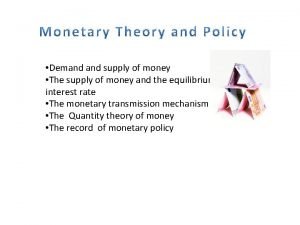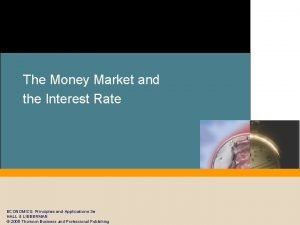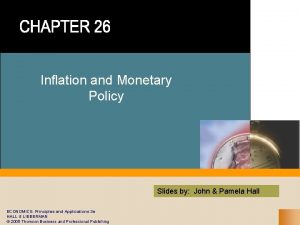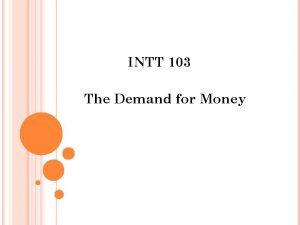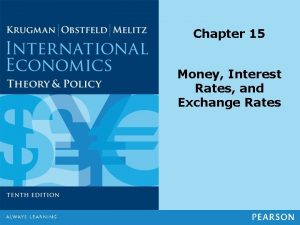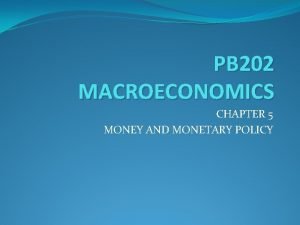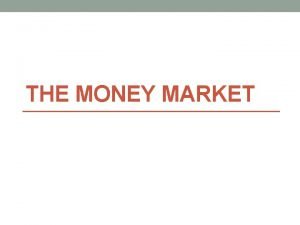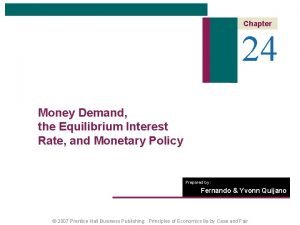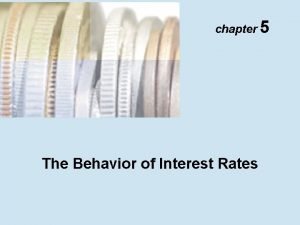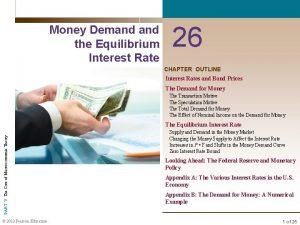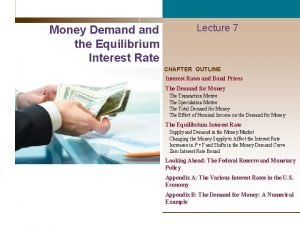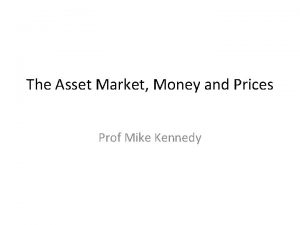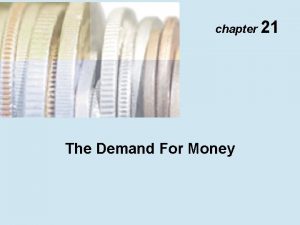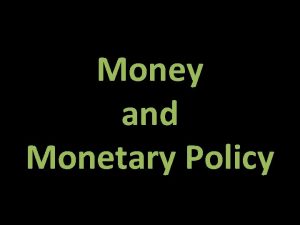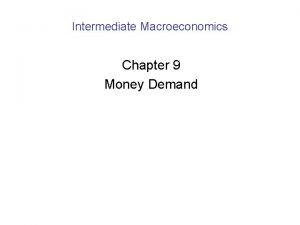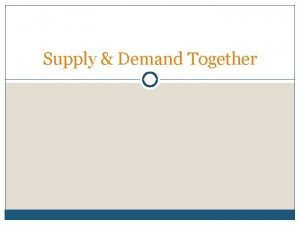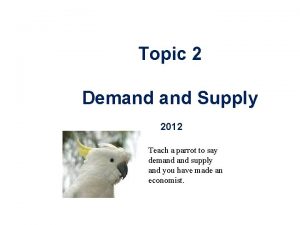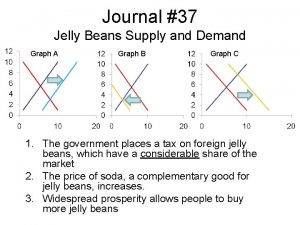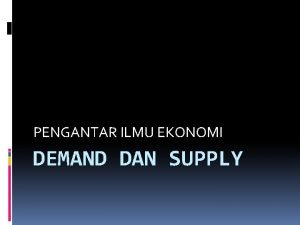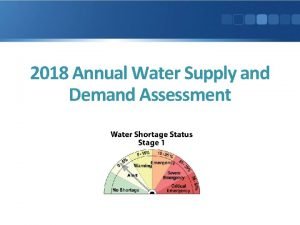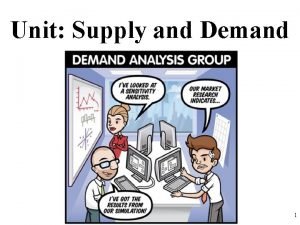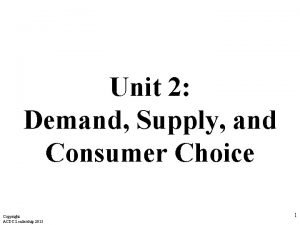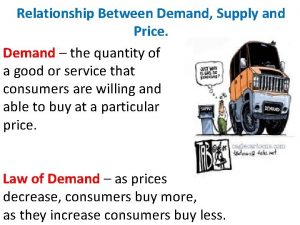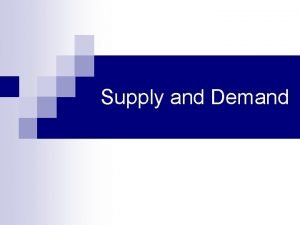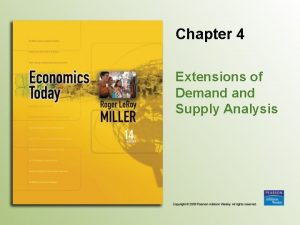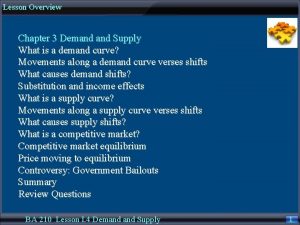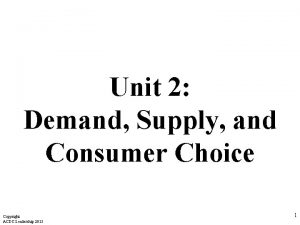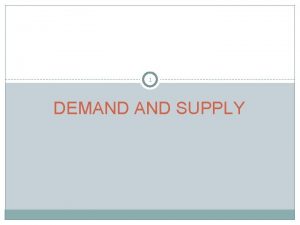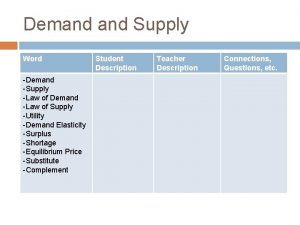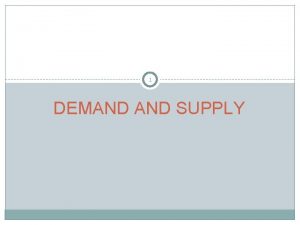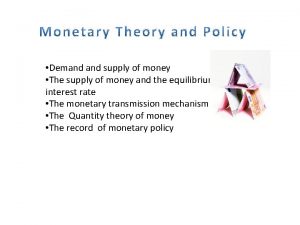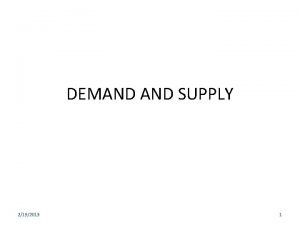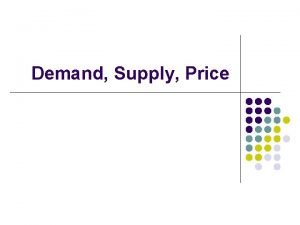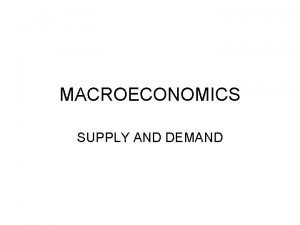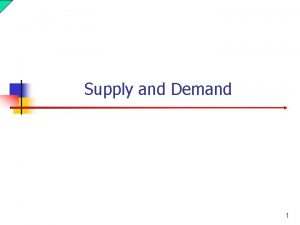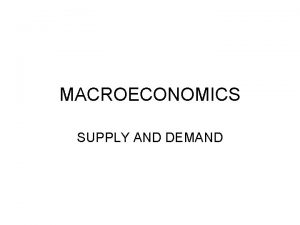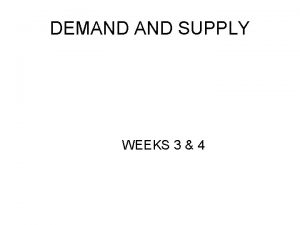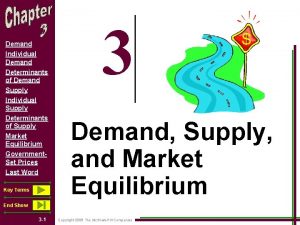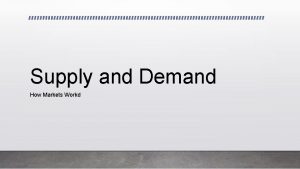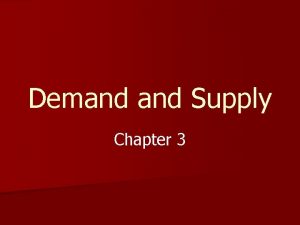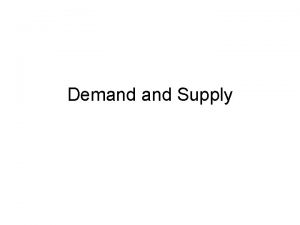Demand supply of money The supply of money












































- Slides: 44

• Demand supply of money • The supply of money and the equilibrium interest rate • The monetary transmission mechanism • The Quantity theory of money • The record of monetary policy

Earlier we said that the interest rate (i) influences aggregate spending— specifically investment and consumption. However, we have yet to develop a theory of the interest rate The interest rate is governed by the demand supply of money.

1. To make planned expenditures/payments 2. To be prepared for unexpected expenditures/payments. 3. To store wealth.

The higher the interest rate, the more interest I give up by holding my wealth in money- as opposed to an interestbearing asset.

Interest rate The money demand, Dm, slopes downward. As the interest rate falls, other things constant, so does the opportunity cost of holding money; the quantity of money demanded increases. Dm 0 Quantity of money 5

Demand for Money Nominal Interest Rate (%) • As we move along MD, the price level and real GDP are held constant. E 6% • The movement from point E to F is a change in the demand for money as a store of value in reaction to a decrease in the yield of bonds. F 3% MD 0 1. 2 Money ($Trillions)

Effect of a Change in Price Level (P) or Real GDP (Y) MD 1 MD 2 Nominal Interest Rate (%) • Increase in P, ceteris paribus. 6% E G • Increase in Y, ceteris paribus H F 3% MD 1 0 1. 12 1. 5 MD 2 Money ($Trillions)

Bond Prices and the Rate Of Interest Bond prices and interest rates (or yields), move inversely

Suppose you paid $800 for a bond that promises to pay $1, 000 to its holder one year from today. What is the interest rate or percentage yield of the bond? Notice first that your interest income would be equal to $200. Hence to compute the yield, use the following equation: Yield (%) = (interest income/price of the bond) 100 Thus, we have: Yield (%) = (200/800) 100 = 25 percent Now suppose, instead of paying $800 for the bond, you paid $900. What is the yield now? Yield (%) = (100/900) 100 = 11 percent

We assume that the Fed (or central banks generally) determines the supply of money

Interest rate Effect of an increase in the money supply Because the money supply is determined by the Federal Reserve, it can be represented by a vertical line. S’m Sm At point a, the intersection of the money supply, Sm, and the money demand, Dm, determines the market interest rate, i. a i b i’ Dm 0 M M’ Quantity of money Following an increase in the money supply to S’m, the quantity of money supplied exceeds the quantity demanded at the original interest rate, i. People attempt to exchange money for bonds or other financial assets. In doing so, they push down the interest rate to i’, where quantity demanded equals quantity supplied. This new equilibrium occurs at point b. 11

i’ Sm S’m a i b Dm i’ (c) Aggregate demand (b) Demand for investment Price level i (a) Supply and demand for money Interest rate Effects of an increase in the money supply on interest rates, investment, and aggregate demand a b P b a AD’ AD DI 0 I I’ M M’ Money Investment An increase in the money supply drives the interest With the cost of borrowing rate down to i'. lower, the amount invested increases from I to I‘. 0 0 Y Y’ Real GDP This sets off the spending multiplier process, so the aggregate output demanded at price level P increases from Y to 12 Y‘


Fed open market purchase injects reserves into the banking system Commercial banks, thrifts, etc. expand loans and deposits The money supply increases The equilibrium interest rate decreases Consumption and investment increase Real GDP, employment, and (perhaps ) the price level increase

Expansionary monetary policy to correct a contractionary gap Price level Potential output LRAS At a, the economy is producing less than its potential in the short run, resulting in a contractionary gap of $0. 2 trillion. SRAS 130 b 130 a 125 AD’ If the Federal Reserve increases the money supply by just the right amount, the aggregate demand curve shifts rightward from AD to AD’. A short-run and long-run equilibrium is established at b, with the pride level at 130 and output at the potential level of $14. 0 trillion AD 0 13. 8 14. 0 Contractionary gap Real GDP (trillions of dollars) 15

The FOMC sets a target for the “federal funds” rate, which is the rate that banks charge other banks for “borrowed” reserves.

Recent ups and downs in the federal funds rate Rate increased to slow redhot economy Global financial crisis prompts rate cuts Rate increase to head off inflation Rate cuts to combat recession Rate cuts to limit impact of mortgage defaults on economy Since the early 1990 s, the Fed has pursued monetary policy primarily through changes in the federal funds rate, the rate that banks charge one another for borrowing and lending excess reserves overnight. 17


The Equation of Exchange Where • M is the quantity of money • V is the velocity of circulation • P is the price level • Y is real GDP

What is velocity (V)? Velocity (V) is the average number of times per year a unit of money is spent for new goods and services. Let (P Y) is nominal GDP. Let P = 1. 25; Y = $8 trillion; and M= $2 trillion. Thus: Or, V = 5

Money and Aggregate Demand in LR • Velocity depends on – Customs and convention of commerce • Innovations facilitate exchange • Higher velocity – Frequency • The more often workers get paid – Higher velocity – Stability (store of value) • The better store of value – Lower velocity 21

Equation of Exchange is Always True The equation simply states that what is spent for new goods and services (M V) is equal to the market value of new goods and services produced (P Y).

Illustration Using the numbers on a preceding slide, we can see that and thus

“Monetarist” interpretation of the equation of exchange The monetarists believe that price level changes (hence inflation) can be explained by changes in quantity of money “Inflation is always and everywhere a monetary phenomenon. ”

Example Assume that V = 5 and is constant. Y is $8 trillion (also assumed to be constant). Initially, let M = $2 trillion

Our basic equation can be rearranged as follows: Now solve for the price level (P): Now let the money supply increase to $2. 4 trillion. Notice that: Thus we have: Notice that:

Hence a 20 percent increase in the money supply causes the price level to increase by 20 percent. Monetarists put the blame for inflation squarely at the doorstep of the monetary authorities (in the U. S. , the FED).

In the long run, an increase in the money supply results in a higher price level, or inflation. Potential output Price level LRAS 140 b 130 a The quantity theory of money predicts that if velocity is stable, then an increase in the supply of money in the long run results in a higher price level, or inflation. Because the longrun aggregate supply curve is fixed, increases in the money supply affect only the price level, not real output. AD’ AD 0 14. 0 Real GDP (trillions of dollars) 28

(a) Velocity of M 1 velocity fluctuated so much during the 1980 s that M 1 growth was abandoned as a short-run policy target. 29

(b) Velocity of M 2 velocity appears more stable than M 1 velocity, but both are now considered by the Fed as too unpredictable for short-run policy use. 30



German Hyperinflation and Money

Record indicates that nations with high rates of monetary growth also suffer high rates of inflation • A decade of annual inflation and money growth in 85 countries (average annual percent) 34

Targeting interest rate vs. targeting the money supply Interest rate Sm S’m If the Federal Reserve holds the money supply at Sm, the interest rate rises from i (at point e) to i ' (at point e'). e’ i’ i An increase in the price level or in real GDP, with velocity stable, shifts rightward the money demand curve from Dm to D'm. e e’’ D’m Dm 0 M M’ Alternatively, the Fed could hold the interest rate constant by increasing the supply of money to S'm. The Fed may choose any point along the money demand curve D'm. Quantity of money 35

The Fed pulled on the string big time beginning in 1979 —it was an anti-inflation strategy under Chairman Paul Volcker

Modeling Contractionary Monetary Policy Price Level Potential GDP AS AD 2 AD 1 0 Y 1 Real GDP


Conventional 30 year www. economagic. com

Monthly payments on a $110, 000 30 year mortgage note Mortgage rate Monthly Payment 1 8% $807. 14 10% $965. 33 12% $1, 131. 47 14% $1, 303. 36 16% $1, 479. 23 1 Does not include prorated insurance or property taxes.

Data in thousands of units www. economagic. go v

More recently, the Fed raised the federal funds rate six times between May 1999 and May 2000—from 4. 75% to 6. 5 %. Evidently unemployment was getting “too low. ”

The FOMC reversed course in July 2000 and cut the funds rate 17 times, to a low of 1. 00 percent in July 2003.

Beginning in 2004, and until summer of 2007, the FED was mainly concerned about inflation.
 Module 5 supply and demand introduction and demand
Module 5 supply and demand introduction and demand Money supply curve
Money supply curve Money market equilibrium
Money market equilibrium Money money money team
Money money money team Matching supply with demand
Matching supply with demand Independent demand and dependent demand
Independent demand and dependent demand Measures to correct excess demand and deficient demand
Measures to correct excess demand and deficient demand Dependent demand examples
Dependent demand examples Individual demand vs market demand
Individual demand vs market demand Demand estimation in managerial economics pdf
Demand estimation in managerial economics pdf Dependent demand operations management
Dependent demand operations management Paradox of value
Paradox of value Stochastic inventory model example
Stochastic inventory model example Grapikong paglalarawan ng relasyon ng presyo at demand.
Grapikong paglalarawan ng relasyon ng presyo at demand. The aggregate real money demand schedule l(r,y)
The aggregate real money demand schedule l(r,y) Built in inflation
Built in inflation What is money multiplier formula
What is money multiplier formula The aggregate real money demand schedule l(r,y)
The aggregate real money demand schedule l(r,y) Demand for money definition
Demand for money definition Objectives of money market
Objectives of money market Money demand curve
Money demand curve Longman
Longman Money demand curve
Money demand curve Money demand and interest rate
Money demand and interest rate Money demand
Money demand Quantity theory of money
Quantity theory of money Money demand curve
Money demand curve Contingent function
Contingent function Money demand
Money demand Supply and demand together
Supply and demand together Supply & demand matching
Supply & demand matching Teach a parrot to say supply and demand
Teach a parrot to say supply and demand The supply and demand for jelly beans
The supply and demand for jelly beans Supply demand schedule
Supply demand schedule Annual water supply and demand assessment
Annual water supply and demand assessment Boba
Boba Aggregate supply and demand graph
Aggregate supply and demand graph Planning techniques
Planning techniques Utility maximization
Utility maximization Combining supply and demand worksheet
Combining supply and demand worksheet Demand and supply analysis
Demand and supply analysis Demand n supply
Demand n supply Extensions of demand and supply analysis
Extensions of demand and supply analysis Coffee supply and demand graph
Coffee supply and demand graph Unit 2 demand supply and consumer choice answer key
Unit 2 demand supply and consumer choice answer key

